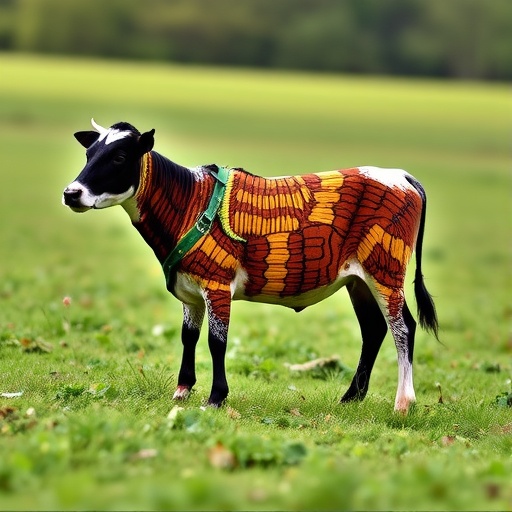In an illuminating study that challenges previous paradigms within immunogenetics, a team of researchers led by Zhou et al. has meticulously detailed the alignment of genome assemblies concerning the bovine T cell receptor (TRG) locus, tapping into the nuances of the IMGT (ImMunoGeneTics) annotation system. This groundbreaking research adds a pivotal layer of understanding to the genomic architecture of the bovine immune system, bringing forth implications not only for veterinary science but also for human health. The bovine species, particularly the domesticated Bos taurus, presents a unique landscape in immunogenetic research due to its complex immune responses and significant economic importance in agriculture and food supply.
Understanding T cell receptor (TCR) diversity is fundamental to appreciating how bovine immune responses operate. TCRs play a critical role in the adaptive immune system, where they recognize foreign antigens and trigger immune responses. In cows, as in other species, the TCR repertoire is influenced by various factors including genetics, environmental exposures, and developmental biology. The recent exploration into the TRG locus of Bos taurus unveils critical insights into how these receptors arise and are utilized for effective immune surveillance and response.
One interesting aspect of the study is the methodology employed by the researchers when benchmarking the alignment of genome assemblies. By comparing different genomic datasets and aligning them to reference genomes, the researchers were able to identify variations and discrepancies in the TRG locus specifically in Bos taurus. This process not only sheds light on the evolutionary dynamics of the immune system in cattle, but also offers a template for analyzing other important loci in the genome.
The IMGT annotation system, which is traditionally associated with human and mouse genomics, has been effectively adapted for bovine genomics in this study. The researchers carefully curated gene and allele information, illuminating the complexity of the bovine TRG locus. This adaptation signifies a broader scope for IMGT in veterinary immunogenetics, catering to species-specific immune repertoire studies, and enhancing our understanding of immune mechanisms across different species.
Furthermore, the implications of this study extend beyond basic research; they cater directly to practical applications in veterinary medicine and livestock management. By understanding the genetic basis of immune responses, breeders can possibly select for animals with more robust immune systems, thus improving herd health, productivity, and overall resilience against diseases. This focus on genomic selection in livestock underscores the intersection of science and pragmatism, where genetic insights can lead to tangible benefits in agricultural practices.
The study’s findings also align with a growing awareness of zoonotic diseases—pathogens that can spill over from animals to humans. Knowing the specifics of bovine immune responses and TCR diversity might equip researchers with tools to preemptively mitigate risks associated with zoonotic transmission. As global agricultural practices evolve, this kind of research provides essential frameworks to ensure safer interactions between humans and livestock.
Additionally, the investigation into the Bos taurus TRG locus highlights the importance of maintaining genetic diversity within cattle populations. The potential loss of genetic variability could stifle future advancements in breeding programs aimed at enhancing disease resistance. Ensuring genetic diversity is crucial for ongoing agricultural resilience, and this research underlines the need for careful consideration of genetic factors when managing livestock populations.
Moreover, the paper posits that the exploration of T cell receptor diversity might uncover novel therapeutic targets, which could transcend bovine diagnostics and therapeutics. The understanding of TCR structure and function has implications in both veterinary and human medicine. This duality offers an exciting avenue for future research, possibly leading to innovative treatments developed from knowledge gained in bovine systems.
The thorough analytical framework applied in this study echoes through various realms of genomic research. As methods for genome assembly and annotation continue to improve, researchers are empowered to undertake increasingly complex studies, redefining our understanding of immune systems. The comprehensive nature of the work presented by Zhou and colleagues sets a precedent for further investigations into the molecular intricacies that dictate immune responses.
Undoubtedly, the collaborative efforts of researchers across different fields of immunology, genomics, and veterinary sciences will be necessary to fully capitalize on the implications of this work. The dialogue between disciplines will enrich our understanding of both fundamental biological processes and practical applications within agriculture and healthcare.
In conclusion, the insights garnered from the bovine TRG locus not only promise to deepen our understanding of bovine immunology, but they also highlight the interconnected nature of wildlife, domestic animals, and human health. As research continues to uncover the complexities of genomics and immune function, this study stands as a testament to the dynamic interplay between evolutionary biology, livestock management, and human welfare.
Through this pioneering investigation, Zhou et al. have opened new frontiers in the study of bovine immunity that warrant continued exploration. The implications of their findings will echo through both scientific literature and agricultural practices for years to come, underscoring the importance of genomic studies in contemporary science.
Subject of Research: Bovine T Cell Receptor (TRG) Locus
Article Title: From benchmarking alignment of genome assemblies to IMGT annotation: the paradigm of the bovine Bos taurus T cell receptor (TRG) locus.
Article References:
Zhou, H., Jiko, C., Gerle, C. et al. From benchmarking alignment of genome assemblies to IMGT annotation: the paradigm of the bovine Bos taurus T cell receptor (TRG) locus.
BMC Genomics 26, 809 (2025). https://doi.org/10.1186/s12864-025-12081-z
Image Credits: AI Generated
DOI: 10.1186/s12864-025-12081-z
Keywords: T cell receptor, Bos taurus, genome assembly, IMGT annotation, bovine immunity, genetic diversity, zoonotic diseases.




